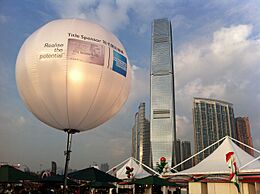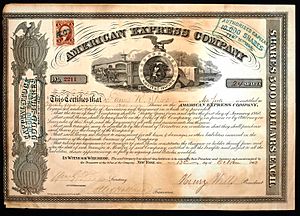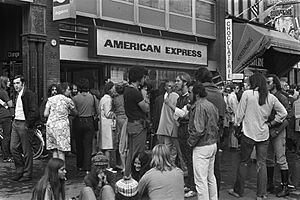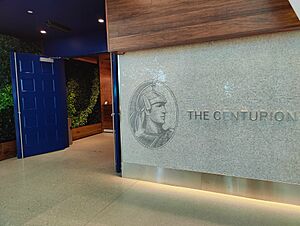American Express facts for kids
 |
|

Headquarters at the American Express Tower
|
|
| Public | |
| Traded as | |
| Industry | Financial Services |
| Predecessor |
|
| Founded | March 18, 1850, in Buffalo, New York, U.S. |
| Headquarters | 200 Vesey Street,
,
U.S.
|
|
Area served
|
Worldwide |
|
Key people
|
|
| Products |
|
| Services | |
| Revenue | |
|
Operating income
|
|
| Total assets | |
| Total equity | |
|
Number of employees
|
75,100 (2024) |
| Subsidiaries |
|
American Express Company, often called Amex, is a big American company that helps people with money. It's known for its payment cards, like credit and charge cards. Its main office is in New York City, in a building called the American Express Tower.
Amex is one of the largest card networks in the world. It's behind companies like China UnionPay, Visa, and Mastercard. As of late 2023, over 141 million Amex cards were used globally. People spent more than $1.7 trillion using Amex cards that year. Amex is also one of the biggest banks in the U.S. It's listed among the top companies on the Fortune and Forbes lists.
Amex started in 1850 by moving goods around. Later, in the early 1900s, it began offering money and travel services. It created its first paper charge card in 1958. Over the years, it introduced different cards like the Gold, Green, Platinum, and Centurion cards. A famous advertising slogan, "Don't Leave Home Without It," started in 1975. During the 2008 financial crisis, Amex became a bank holding company. Since 2013, Amex has also opened special airport lounges for some of its cardholders.
In 2023, Amex handled about 9% of all card transactions worldwide. While most places in the U.S. accept American Express cards, they are less common in Europe and Asia. Amex offers many types of cards. These include cards for travel, dining, everyday spending, and getting cash back. Each card has different benefits and rewards. Popular cards like the Green, Gold, and Platinum cards are great for people who travel or eat out a lot.
Contents
History of American Express
How Amex Started
American Express began in 1850 in Buffalo, New York. It started as a company that moved goods and money. Three companies joined together to form it. The founders, Henry Wells and William G. Fargo, also started Wells Fargo & Co. a few years later.
Amex first had its main office in New York City. For many years, it was almost the only company moving goods and money across New York State. In 1874, Amex moved its headquarters to a new location in the Financial District.
The company grew a lot. By 1903, it was one of the biggest financial companies in New York City. In 1916–1917, Amex built a large, new 21-story headquarters building at 65 Broadway. This building was part of a group of similar office towers. Amex sold this building in 1975, but it still kept its travel services there.
Growing Across the Country
American Express grew by working with other shipping companies, railroads, and steamship lines. In 1857, Amex started a money order business. This allowed people to send money safely.
A big change happened in 1891 when Amex introduced the Traveler's Cheque. This was a new way for people to carry money safely when they traveled. It was created because the company's president, J. C. Fargo, found it hard to get cash while traveling in Europe.
Traveler's cheques helped Amex become a worldwide company. When World War I started in 1914, many Americans were stuck in Europe. Other banks wouldn't help them get cash. American Express was one of the few companies that honored their money documents. The British government even asked Amex to deliver letters, money, and packages to British prisoners of war. Amex employees went into prison camps to help prisoners get money from home.
In 1915, American Express started its travel division. It soon opened its first travel agency.
End of the Railroad Business
During World War I, the U.S. government took control of the railroads. This was to help move troops and supplies. All agreements between shipping companies and railroads were canceled. The government decided to combine all existing shipping companies into one new company. This new company, called the American Railway Express Agency, started in 1918. This meant American Express stopped its railroad shipping business. Amex had been the largest part of this business, owning rights to shipping over thousands of miles of railroad lines.
From the 1920s to the 1970s
American Express thought about creating a travel charge card as early as 1946. But it wasn't until another company, Diners Club, launched a card in 1950 that Amex got serious. On October 1, 1958, Amex launched its own card. It was so popular that 250,000 cards were given out before the official launch. The first cards were made of paper. In 1959, Amex was the first company to use plastic cards with raised numbers.
In 1966, Amex introduced the Gold Card for people who spent a lot of money.
In 1979, American Express bought part of Warner Communications' cable TV business. This created Warner-Amex Satellite Entertainment. This company owned channels like MTV and Nickelodeon. However, it didn't make money, so Amex sold its share in 1985.
The 1980s and 1990s
In the 1980s, American Express tried to become a bigger financial services company. It bought several businesses, including a large investment firm called Shearson Loeb Rhoades in 1981. This made Amex a major player in the stock market business.
In 1984, Amex launched the Platinum Card. This was a very special card with a high yearly fee. It was only offered to Amex customers who had used their cards for a long time, spent a lot, and always paid on time. In 1987, Amex introduced the Optima card, which was its first credit card that didn't have to be paid in full every month.
In 1989, American Express publicly apologized and donated $8 million to charity. This was after false accusations were made against a banker named Edmond Safra.
In 1991, some restaurants in Boston stopped accepting American Express cards. They preferred Visa and Mastercard because Amex charged higher fees. This event was called the "Boston Fee Party." It spread to other cities. To fix this, Amex lowered its fees. The company then changed its focus from being super exclusive to being accepted by more places, like Walmart.
In 1993, American Express sold its brokerage business, Shearson, to another company. This ended Amex's time in the stock brokerage business.
In 1998, Amex launched the Blue credit card, aimed at younger adults. It had a smart chip and encouraged users to manage their accounts online. In 1999, American Express introduced the high-fee Centurion Card, often called the "black card." This card was for very wealthy customers. It was created because of rumors that Amex had a secret, super-exclusive black card.
The 21st Century
In 2004, rules that stopped U.S. banks from issuing American Express cards were removed. This happened after a lawsuit by the United States Department of Justice. This allowed other banks to start offering Amex cards.
In 2005, American Express introduced ExpressPay, a way to pay by just tapping your card. It also launched the American Express Travelers Cheque Card, a stored-value card that worked like a traveler's cheque but could be used like a credit card. This card was stopped in 2007.
In 2006, the UK part of American Express joined the Product Red program. They issued a Red Card, and with each purchase, money was donated to help people with HIV/AIDS and other diseases in Africa.
In 2008, during the 2008 financial crisis, American Express got approval to become a bank holding company. This allowed it to get government help. Amex repaid this help in 2009.
In 2012, American Express had to refund about $85 million to customers. This was because of misleading statements and unfair fees. Also in 2012, Amex and Walmart launched Bluebird, a prepaid debit card that could be used like a bank account.
In 2013, Amex opened its first airport lounge. These lounges offer special access to certain card members.
In 2014, American Express spun off its corporate travel business. It sold half of it to an investor group.
In 2016, Costco ended its long-standing partnership with Amex in the United States. Costco had been the last major U.S. store that only accepted American Express cards. This change had a big impact on Amex's business.
In 2017, American Express started a new company in China to offer its payment cards there. In 2020, it got a license to operate its card clearing business in China.
In 2018, the Gold Card in the UK became a credit card, but it remained a charge card in the U.S. In 2019, Amex bought LoungeBuddy, which helps people access airport lounges.
In 2020, American Express bought Kabbage, a company that helps small businesses. In 2021, Amex launched Kabbage Checking, its first checking account for small businesses. The Kabbage brand was renamed American Express Business Blueprint in 2023.
In 2022, after the Russian invasion of Ukraine, American Express stopped all its operations in Russia and Belarus.
In 2023, Amex agreed to pay $15 million to the U.S. Treasury. This was to settle an investigation about how it handled small business customers. In 2024, Amex bought Tock, a company that helps with restaurant reservations.
Financial Growth
| Year | Revenue | Net income |
|---|---|---|
| 2024 | 65.9 | 10.1 |
| 2023 | 60.5 | 8.4 |
| 2022 | 55.6 | 7.4 |
| 2021 | 43.6 | 7.9 |
| 2020 | 38.1 | 3.0 |
| 2019 | 47.0 | 6.6 |
| 2018 | 43.2 | 6.7 |
| 2017 | 38.9 | 2.6 |
| 2016 | 37.1 | 5.2 |
| 2015 | 34.4 | 5.0 |
| 2014 | 35.8 | 5.8 |
| 2013 | 34.8 | 5.3 |
| 2012 | 33.7 | 4.4 |
| 2011 | 32.2 | 4.8 |
| 2010 | 30.0 | 4.0 |
| 2009 | 26.5 | 2.1 |
Amex Card Benefits and Fees
Cards for Businesses
American Express offers special credit cards for businesses. These include cards for corporate meetings and purchasing cards for employees or departments. These cards come with tools to help companies manage their spending and accounting.
Cards from Other Banks
Some other banks also issue American Express cards. These include Citibank, First National Bank of Omaha, USAA, and US Bancorp. Some credit unions also offer Amex cards.
Marketing and Advertising

Card Design
The American Express logo shows a gladiator or centurion. This figure is often in the middle of many Amex cards. It looks like something from ancient times and shows strength. The designs on the cards, especially the Green card, look similar to U.S. money.
Advertising Campaigns
"Don't Leave Home Without Them"
In 1975, a very successful ad campaign started for American Express Traveler's Cheques. It featured actor Karl Malden. He was the face of Amex Traveler's Cheques for 25 years.
Later, as the cards became more important, Amex used other famous people in its ads. A typical ad would start with a celebrity asking, "Do you know me?" The ad would give hints about who they were, but their name was only shown on an American Express Card. The ad would end with the celebrity saying, "Don't Leave Home Without It." This slogan was brought back in 2005.
The Adventures of Seinfeld & Superman
American Express has used many celebrities in its ads. In the late 1990s, comedian Jerry Seinfeld was in a campaign. This included two online videos in 2004 called "The Adventures of Seinfeld & Superman".
"My life. My card. / Are You a Cardmember?"
In late 2004, Amex launched a new ad campaign called "My life. My card." Later, in 2007, it started "Are You a Cardmember?" Both campaigns featured celebrities who used American Express cards. These included actors like Kate Winslet and Robert De Niro, talk show host Ellen DeGeneres, golfer Tiger Woods, and singers like Alicia Keys and Beyoncé.
"Animals"
In 2007, a two-minute black-and-white ad called "Animals," starring Ellen DeGeneres, won an award for being an outstanding commercial.
C. F. Frost
Many American Express credit card ads show a sample card with the name "C. F. Frost" on it. This is not a made-up name. Charles F. Frost was an advertising executive who worked on the Amex campaigns.
Cause Marketing
American Express was one of the first companies to use "cause marketing." This is when a company links its sales to a good cause. In 1983, Amex promised to donate one penny to help fix the Statue of Liberty for every purchase made with an American Express Card. This campaign raised $1.7 million for the Statue of Liberty. It also made people use their Amex cards about 28% more!
In 2007, Amex started the Members Project. Cardholders could suggest ideas for projects, and Amex would fund the winning one.
Sponsorships
Since 2011, American Express has sponsored the football club Brighton & Hove Albion F.C. This includes naming rights for their stadium, training facilities, and sponsoring their team jerseys.
In May 2024, American Express became an official partner of F1 Academy. This is a racing series just for female drivers. Amex's logo appears on one of the race cars and the driver's suit.
Awards and Recognition
In 2016, American Express won an award for its "World's Monument Watch" program. This program helps restore important historical sites around the world. Amex has sponsored this program since 1995.
Workplace
Offices Around the World


In 1986, American Express moved its main office to the 51-story Three World Financial Center in New York City. After the September 11 attacks in 2001, the building was damaged. Amex employees had to leave temporarily but started moving back in 2002.
Amex also has big offices in places like Sunrise, Florida; Salt Lake City, Utah; and Phoenix, Arizona. Its main computer centers are in North Carolina and Phoenix.
AMEX Bank of Canada started in 1853 in Toronto. It has about 1,700 employees in its main office in Toronto. It also has an office in Hamilton, Ontario.
American Express has several offices in the UK. Its European Service Center is in Brighton, England. This building was finished in 2012. It replaced an older building called Amex House. The European Service Center handles card services, sales, and fraud. Amex's main office for Europe, the Middle East, and Africa is in central London. Other UK offices are in Burgess Hill and Manchester.
The headquarters for Japan, Asia-Pacific, and Australia are in Singapore and Sydney. The main office for Latin America and the Caribbean is in Fort Lauderdale, Florida.
American Express also has a large presence in India. Its two centers are in Gurgaon and Bangalore. These centers help with customer services and the credit card business in India. The Gurgaon campus is one of Amex's largest employee locations.
Job Satisfaction
American Express has often been named one of the best companies to work for by magazines like Fortune.
List of CEOs
- Henry Wells (1850–1866)
- William Fargo (1866–1881)
- J. C. Fargo (1881–1914)
- George C. Taylor (1914–1923)
- Frederick P. Small (1923–1944)
- Ralph Reed (1944–1960)
- Howard L. Clark Sr. (1960–1977)
- James D. Robinson III (1977–1993)
- Harvey Golub (1993–2001)
- Kenneth Chenault (2001–2018)
- Stephen Squeri (2018–present)
See also
 In Spanish: American Express para niños
In Spanish: American Express para niños
- Small Business Saturday, a special shopping day created by American Express
- MasterCard, Visa and Discover Card – other big card companies
- American Express Community Stadium in East Sussex, England








